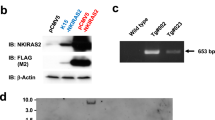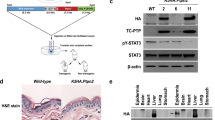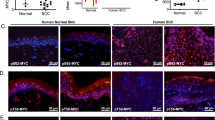Abstract
In recent work we showed that the EGF receptor (EGFr) was activated in tumor promoter treated mouse epidermis (Cell Growth & Differentiation, 6: 1447 – 1455, 1995). In the present study, we have investigated the possible role of other erbB family members in the process of tumor promotion. Both erbB2 and erbB3, but not erbB4, were expressed in cultured mouse keratinocytes and in mouse epidermis in vivo. In cultured mouse keratinocytes, EGF stimulated rapid tyrosine phosphorylation of erbB2 followed by a time-dependent degradation of erbB2 protein. Furthermore, an increase in erbB2 : EGFr heterodimer formation was also induced by EGF. In contrast to the results with erbB2, EGF did not induce tyrosine phosphorylation, the degradation of erbB3, or erbB3 : EGFr heterodimer formation in cultured keratinocytes. Further analyses revealed that c-src kinase activity was dramatically elevated in cultured mouse keratinocytes exposed to EGF. In mouse epidermis following multiple treatments with 12-O-tetradecanoylphorbol-13-acetate (TPA), the phosphotyrosine content of erbB2 was significantly elevated in a dose-dependent manner. Concomittantly, erbB2 : EGFr heterodimer formation and c-src kinase activity were also elevated in TPA-treated epidermis. Structure-activity relationships with several phorbol ester analogs showed that the elevated phosphorylation of erbB2 in mouse epidermis followed closely with tumor promoting ability. Activation of erbB2 and c-src kinase were also observed in the epidermis of TGFα transgenic mice where expression of human TGFα was targeted to basal keratinocytes with the human K14 promoter. Collectively, the current data suggest that the activation of erbB2 in phorbol ester treated skin can be explained solely by a mechanism involving elevation of EGFr ligands and activation of the EGFr. In addition, activation of c-src may be an important downstream effector in mouse keratinocytes both in vivo and in vitro, following activation of the EGFr, erbB2, or both.
This is a preview of subscription content, access via your institution
Access options
Subscribe to this journal
Receive 50 print issues and online access
$259.00 per year
only $5.18 per issue
Buy this article
- Purchase on Springer Link
- Instant access to full article PDF
Prices may be subject to local taxes which are calculated during checkout
Similar content being viewed by others
Author information
Authors and Affiliations
Rights and permissions
About this article
Cite this article
Xian, W., Rosenberg, M. & DiGiovanni, J. Activation of erbB2 and c-src in phorbol ester-treated mouse epidermis: possible role in mouse skin tumor promotion. Oncogene 14, 1435–1444 (1997). https://doi.org/10.1038/sj.onc.1200980
Received:
Revised:
Accepted:
Issue Date:
DOI: https://doi.org/10.1038/sj.onc.1200980
Keywords
This article is cited by
-
Loss of DLX3 tumor suppressive function promotes progression of SCC through EGFR–ERBB2 pathway
Oncogene (2021)
-
Epidermal growth factor receptor dimerization status determines skin toxicity to HER-kinase targeted therapies
British Journal of Cancer (2006)
-
Differential Utilization and Localization of ErbB Receptor Tyrosine Kinases in Skin Compared to Normal and Malignant Keratinocytes
Neoplasia (2001)
-
Constitutive expression of erbB2 in epidermis of transgenic mice results in epidermal hyperproliferation and spontaneous skin tumor development
Oncogene (2000)



